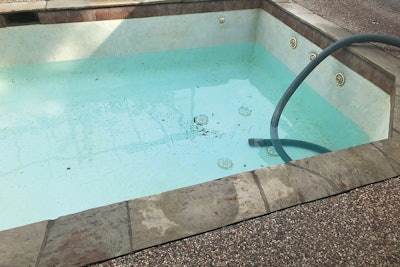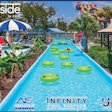
The first thing you need to get past is the thought that somehow having to drain, refill, and start fresh is giving up or failing. Instead, it may be a testament to your chemistry or water treatment acumen. In other words, it may be a solid decision made from knowledge and experience. But a lot goes into this, and the job’s profitability is right at the top of the list.
Before considering this as an option, you must determine if water replacement is an option. If the pool is located in an area with drought restrictions, dumping water is off the table. Some places, like Florida, require the pool service professional to be a licensed contractor to remove water from a swimming pool. Groundwater levels may play a role. Then, we have insurance coverage to consider.
POP-UP INSURANCE
Pool pop insurance is often an exclusion in general liability insurance. This is something that must be added to your policy. Without it, you are liable for the damage, including demo, landfill, and the cost of a new pool. News flash: Homeowner’s insurance policies typically do not cover this mother of a catastrophe. This means the total cost is on the person who removed the water. It is insane not to carry the insurance that will cover it. We can jump into the need for well-points, but that is an entire article by itself, so we will save it for another time.
TECHNICAL ACUMEN
As you contemplate the problem that has led you to this crossroads, the correct solution will always be the one that is within your skillset, that works the fastest at the most reasonable expense and sets the foundation for excellent water quality in the long term. That may be treating the water chemically or rebuilding the equipment pad, but it could also be to empty the sucker out and turn on the hose. Don’t be a schlemiel — if replacing the water meets the aforementioned requirements, replace the Fakakta water!
BUT WATER IS EXPENSIVE!
Lies, lies, lies. I decided to poke around a bit using my 16,000-gallon pool as an example. I know. It’s not a massive pool by Northern U.S. standards, but trust me, it falls in at the high side of average here in Florida. Regardless, GRU would charge me $55.20 for 16,000 gallons of water in Gainesville, Fla. (where I live). According to Harris County Municipal Utility District 501 in Houston, Texas, that same amount of water would only be $105.92. Then, in the City of Angels, LADWP comes in high but is still only a $273.66 water charge.
Break for filling a pool? Some areas will waive the wastewater fee under certain conditions. Apparently, it’s not the City I live in, but it doesn’t hurt to call and see what’s what. Sticking with the sampling of three I had used as examples before, this is what I’ve found.
GRU (Gainesville Regional Utilities): Nope. Nada. Nien. No discount for you!
Houston Public Works Application for Newly Constructed Swimming Pool Credit: A single-family residential customer may apply for an adjustment for credit on sewer charges associated with the customer’s initial filling of a newly constructed and permitted pool within six(6) months of the day the pool passes the City’s final inspection.
Los Angeles Water & Power: You may be eligible for a Sewer Service Charge (SSC) adjustment if you filled your pool during the winter rainy season (typically from October through April). To request an adjustment, contact the City of Los Angeles Department of Public Works, Bureau of Sanitation at 1(800)-540-0952 or fill out and submit a Residential SSC Request for Adjustment.
CYA IN NY, FUHGEDDABOUDIT!
Commercial properties with erosion feeders full of trichlor in a state with a pool code don’t have a choice. That CYA (Cyanuric Acid) level will come a creeping, and when it hits 90 ppm, the DOH will demand you bring that level down. Remember, everything you add increases or decreases what you want but always increases something else. 15 ounces. of trichlor will add 10 ppm of FAC to 10,000 gallons, but it will also increase the CYA by 6 ppm and the TDS by 10 ppm.
Unless you are in an area with water restrictions, I won’t mess around with chemical methods of dropping CYA levels like a boombots (even my alum- CYA removal method was developed only with drought areas in mind). Facts are facts; even with options like RO (reverse osmosis) that do have their place, replacing water will always be the quickest and most cost-effective means of lowering the CYA level in a swimming pool. The same applies to Calcium Hardness. However, a chemical solution does exist in drought-stricken areas, courtesy of my friends Que, Doug, and Kim at onBalance. Google that on your own time.
COUNTY WATER REPORTS
You should be aware of some other stealthy shenanigans that could be a factor in ‘problem’ pools. We know that when water evaporates, the only thing that leaves the water is water. Everything else in your fill water only increases in concentration every time the water is topped off. It is wise to go beyond testing the fill water and pull your county’s water report to determine what you should be testing for in addition to the norm — things like metals, nitrates, silicates, etc.
When the level of impurities exceeds the recommended limits, and the cost of chemical reduction surpasses the dollar value of a drain and fill, replacing water again becomes the better option, providing that the level in the fill is lower than that in the pool. If the Calcium Hardness level of the water in your pool is 500 ppm and the level out the tap is 500 ppm, the only thing you’ll change in a drain and fill is EVERYTHING except the Calcium Hardness level.
I understand that some homeowners and facilities might not be on board with this, no matter how well you prove the decision’s immediate and long-term economic benefit. At this point, should they refuse, I see no choice but to raise the rates for having to deal with the treatment of a pool that will be harder to maintain because they will not follow your expert advice.
NATURAL DISASTER
There are times when we cannot attest to the success of a treatment. After all, it is not all about aesthetics; the water must also be safe to swim in. In the case of vandalism (FYI — we do not drain a pool that has been violated with paint or motor oil) or natural disaster, such as wildfire, it is not enough to simply regain clarity. We need to be sure there’s nothing toxic in there. In the case of a local wildfire, to know how to treat the water means to know what is in the smoke and how to treat that. I know no one in smoky areas is going to like that I added this one or even believe that it is necessary, but take a look at this:
According to the EPA, wildfire smoke is comprised of a mixture of gaseous pollutants (e.g., carbon monoxide), hazardous air pollutants (HAPs) (e.g., polycyclic aromatic hydrocarbons [PAHs]), water vapor, and particle pollution (acids (e.g., sulfuric acid,) inorganic compounds (e.g., ammonium sulfate, ammonium nitrate, and sodium chloride), organic chemicals, soot, metals, soil or dust particles, and biological materials (e.g., pollen and mold spores). It is oobotz to believe enzymes, clarifiers, and chlorine will remove these toxins without proof. Do you know which is a dermal absorption threat and at what level? Me neither. Capeesh?
EXTREME WEATHER EVENT
In Southwest Florida, we currently have swimming pools filled with seawater due to the storm surge caused by Hurricane Ian a year ago. These pools have not been attended to yet, not because water with a Total Dissolved Solids level greater than 30,000 ppm is suitable for pools, but because the extent of the damage was so vast that pool service companies in the area have yet to catch up. We notice an odd occurrence on those we have been able to drain and fill. Not only have the pool walls become supersaturated with salt to the point that the sodium weeps from the walls, similar to calcium nodules, but many pool techs have also now had to add barnacle removal from plaster to their service offerings.
CRITTER SH*@TER!
If a trash panda has visited your customer’s pool, it is not uncommon to find that they have left you a present on the very top step. Raccoon feces are one of the scariest gifts in pool water. These walking Davey Crockett caps are known carriers of Baylisascaris procyonis (the raccoon roundworm). A carrier raccoon can shed as many as 250,000 eggs per gram of feces. If ingested by a human and the egg should hatch, the nematode, growing up to 11 centimeters, can penetrate the gut wall and enter a person’s bloodstream.
Sadly, no chlorine level can penetrate the Baylisascaris egg’s thick wall. This, according to the CDC, leaves us with two treatment options for pool water. The first step is to contact animal control and have them test the fecal matter for the roundworm.
If the roundworm is present:
Option 1:
- Backwash the pool filter.
- Drain and hose down the pool.
- Use disposable gloves to replace the sand, D.E., or cartridge (depending on filter type). Double bag the discarded media in plastic garbage bags. Remove gloves and place them in the garbage bags. Wash your hands thoroughly with soap and water afterward.
Luckily, the Baylisascaris egg is giant (55 micrometers to 65 micrometers), giving us an often more desirable second option. It can be filtered out, providing you run the filter for a long enough time, a minimum of four turns, followed by a good backwash. Sadly, you will still need to replace the filter media following the same precautionary measures as in step one.
SUICIDE
Two or three times a year, I receive a phone call from some part of the country asking for the steps to follow upon finding a deceased person in a swimming pool. Enough so that I am probably the only person in the industry who has a written procedure to follow. The initial steps are regarding the contact and reporting to the local police department, including what one should do while awaiting their arrival on the scene. After that, we delve into the treatment of the water, and believe it or not, draining the swimming pool is not required as long as you follow the protocol to the Tee. However, it is a dead person, and most people aren’t going to care how much of what chemical has gone into a swimming pool for treatment — they don’t want to swim in any water where a body has been.
STAY WITHIN YOURSELF
This list of waterborne catastrophes likely needing drain and refill is not exhaustive, but it’s a start. If you see something I missed — let me know!
Remember, the critical factors in making the decision to drain over attempting to remediate the backyard bog are the skillset of the pool service pro, the cost of the treatment compared to the cost of water, time and, of course, the profitability of each option. I’ve seen many service pros attempt to WOW a customer in a display of chemical prowess only to end up losing their ass and hating life. Don’t let this be you.












































